Contents
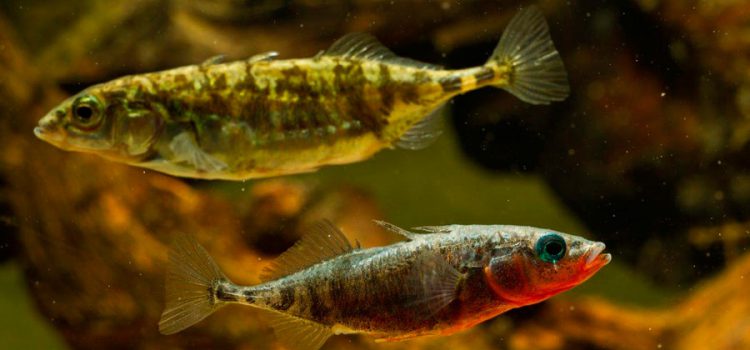
The stickleback is a freshwater fish of small size, representing a species of ray-finned fish and belonging to the order of sticklebacks. Under this name, there are several varieties of fish that have one characteristic feature, because of which the fish got this interesting name.
The three-spined stickleback differs from other fish in that it has three spikes that are located on the back, in front of the fin. About how interesting this fish is and where it lives will be discussed in this article.
Three-spined stickleback: fish description
Appearance

Firstly, the fish is relatively small, although not as small as, for example, perch. It can grow in length up to 12 cm no more, with a weight of several tens of grams, although more weighty individuals can also be found.
The body of this fish is elongated and strongly compressed laterally. At the same time, the body of this amazing fish is protected from enemies. As a rule, she has three prickly spikes on her back, next to the fin. There are also a pair of sharp needles on the abdomen, which serve for fish instead of fins. In addition, the fused pelvic bones on the belly, at one time, served as a shield for the fish.
There is another interesting feature associated with the lack of scales. Instead, there are transverse plates on the body, the number of which ranges from 20 to 40. Similar plates are located in the back area, which is colored in a greenish-brown hue. The belly of this fish is distinguished by a silvery color, and the chest area is colored red. At the same time, during the spawning period, the chest area takes on a bright red hue, and the back area changes to bright green.
Behavior
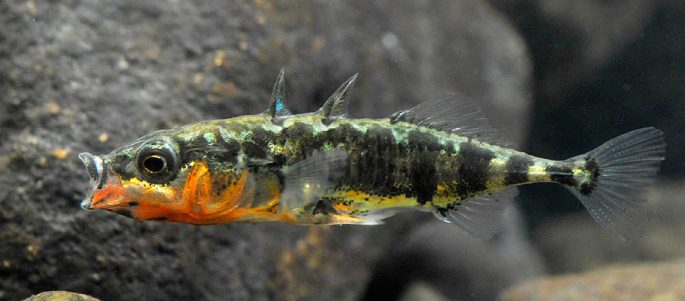
This type of fish can be found in both fresh and slightly salty water. At the same time, the stickleback chooses water bodies with a slow current. These can be rivers and lakes of small size with a muddy bottom and thickets of aquatic vegetation. The fish keeps in numerous flocks. Flocks move around the pond very actively and react to any object that has fallen into the water. In this regard, the stickleback quite often gets on the nerves of anglers, constantly roaming at the fishing point.
Spawning
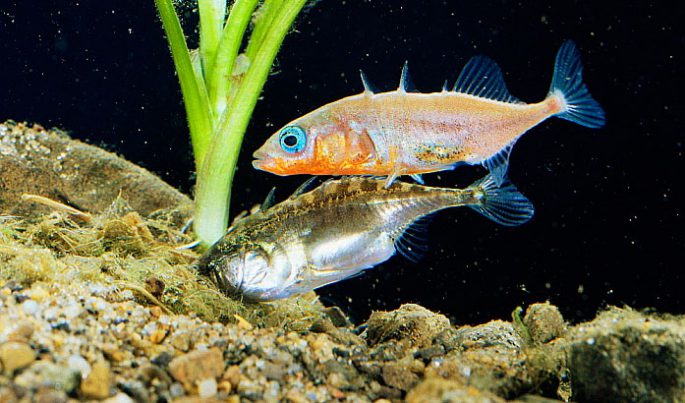
Despite the fact that the female can lay no more than 100 eggs, the stickleback breeds very actively. During the spawning period, this fish forms a kind of nest where the female lays her eggs. After that, the males begin to take care of the offspring.
During the spawning period, female sticklebacks are distinguished by a brighter color.
Before the start of spawning, they have clearly assigned responsibilities between females and males. Males are responsible for nest formation and finding places to do so. As a rule, they build nests in the muddy bottom or in the grass next to the water lilies. They use silt and pieces of grass to build ball-like nests.
After the nest is built, the male looks for a female, who lays eggs in his nest, after which he fertilizes her. At the same time, the male can find more than one female. In this case, his nest may contain eggs from several females.
The spawning period can stretch up to one month. As soon as the fry are born, the male takes care of them, driving away predators. At the same time, he does not allow the young to swim too far. And yet, despite such care, only a third of the young animals manage to survive.
stickleback enemies
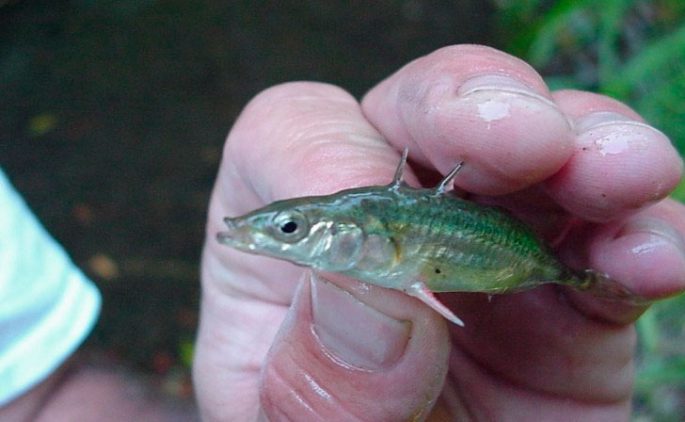
Since the three-spined stickleback has spikes on its back and needles on its belly, it can defend itself from enemies. Despite this, she has natural enemies, such as zander or pike. If a fish is attacked by a predatory fish, then it spreads its spikes, which pierce into its mouth. In addition to predatory fish, birds such as gulls prey on stickleback.
Where is the stickleback found
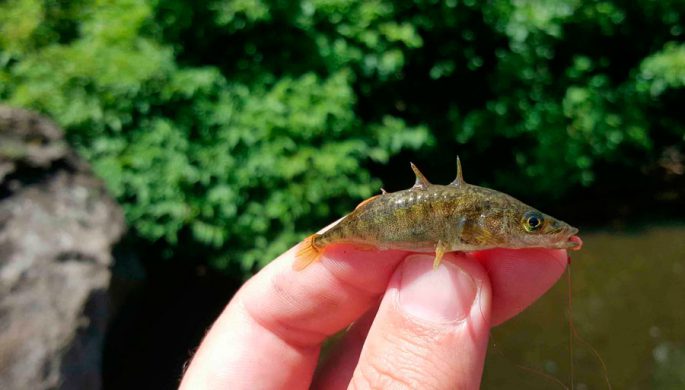
This fish inhabits almost all European water bodies, such as lakes and rivers. In addition, it is ubiquitous in the waters of North America.
On the territory of Russia, the three-spined stickleback is found in the rivers and lakes of the Far East, and more precisely in Kamchatka. The stickleback, although rare, is found on the territory of the European regions of Russia, including in Lake Onega and in the delta of the Volga River.
© Three-spined stickleback (Gasterosteus aculeatus)
The economic value of the stickleback

For fishermen, this fish is a real disaster, as it rushes about in flocks around the pond and rushes at any object that has fallen into the water. Moving in flocks, it creates additional noise in the water column at the fishing point, which scares away other fish. In addition, this fish does not differ in acceptable sizes, and the presence of thorns scares off most fishermen. In Kamchatka, where stickleback is found everywhere, the locals call it only “khakalch”, “khakal” or “khakhalcha”.
In fact, it is considered a weed fish and is not caught on an industrial scale. Despite this, the stickleback is used in medicine, extracting the highest quality fat from it, which promotes wound healing, especially after burns. In addition, it is permissible to obtain technical fat from it for use in industry. If it is processed properly, then it is possible to obtain fertilizer for the fields, as well as to produce fodder meal. Poultry also will not refuse such a nutritious feed.
More recently, and even in our time, local residents of the Far East caught stickleback and used its fat to prepare other homemade dishes. Oddly enough, but stickleback oil has no smell, compared to other fish fat. In addition, its fat is given to children in order to prevent various ailments.
If desired, you can cook an ear from a stickleback, only it will turn out to be too bony and not very rich, unless you use the largest individuals if you manage to catch them.
Some hobbyists place the stickleback in an aquarium, although it is necessary to have a sufficiently large capacity to keep it. In addition, for its successful maintenance, appropriate conditions are needed. The fact is that during spawning periods, males show maximum aggression towards other males, and for this you need to have a lot of living space. The bottom of the aquarium should consist of a sand base, and the lighting should be more close to natural. As a rule, the three-spined stickleback does not tolerate bright light.
In conclusion

Despite the fact that this fish is not large, but vice versa, and therefore is not of particular interest to both anglers and commercial needs, it may be useful in the future. This is due to the fact that fish species of interest to anglers and industry over time may simply disappear due to mass fishing.
Of interest is her fat, which has no smell, although many people know the smell of fish oil, from which it immediately becomes uncomfortable. Therefore, it is preferable to use it in medicine, especially since today there is no information about seafood that would be useless for humans. As a rule, fish oil is a healthy fat that can cleanse blood vessels.
No less attractive can be considered the option of using technical fats produced on the basis of fish oil. And here such a seemingly weedy fish can play a significant role in the rise of industry. After all, it is no secret to anyone that because of the price of oil, the prices of its derivatives are also growing.
Underwater Wild Series/Three-spined Stickleback (Gasterosteus aculeatus) — Animalia Kingdom Show









